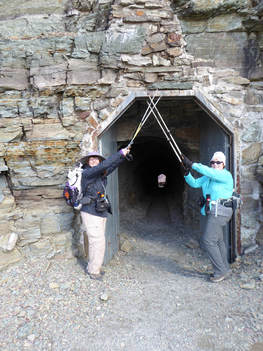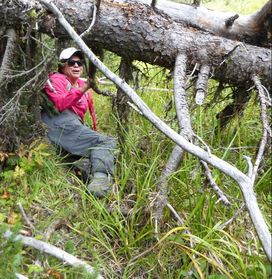Mary S. Finally Climbs Crown Butte
 The GiG has climbed Crown Butte four times: 2012, 2013, 2014, 2015, but Mary S has never been able to make it. Plus we had at least three other trips planned, but the weather and gumbo roads prevented us from going. So it almost seemed like a miracle when it didn't rain, the roads were good and we made it to the parking lot without incident We did have a few cows blocking the road (and a dead one to drive around), which Mary expertly navigated. The weather was nice, very slight breeze, some clouds and haze from the smoldering fires. We made it to the top easily, enjoying some late flowers (showy and white asters, blazing star/gay feather, Canadian goldenrod. The fall colors were just starting, and currants plentiful. Along the trail, we saw much bear scat with berries. We also saw one live and one dead mouse and a snake at the very end of the day. The snake coiled and made some noise, making us think it might be a rattler; but then we saw a pointed tail and knew it was just a bull snake, thankfully. We also saw hawks (or maybe harriers or falcons) and heard them. We even saw one try to make a meal of a magpie, but they all flew off cawing. When we neared the top, we saw an abandoned bike. We were amazed at the athleticism the person must have to be able to bike up the steep trail. And since we didn't see any other car around, we knew the person must have pedaled the 7 or more miles of dirt road. We wondered who it might be. But we didn't find out. We saw no one on the top; the bike was still there when we left. On top, we had a fun look-see around the rim, admiring the lime-green lichen, the spires of shonkinite with its black embedded augite crystals creating interesting formations on the edge of the butte. We also wondered about the cracks in the rock that almost looked like they had mortar in them. In places, the spires looked man-made. We did find the Nature Conservancy sign on an overlook facing Square Butte. We left GF at 10 a.m. and returned by 4 p.m. after a stop at the Mennonite deli. Read more about Crown Butte here. Visit Montana Virtual field trip with geology (won't work on most mobile devices) Who went: Karen, Mary S, Katie | Info from Nature Conservancy Crown Butte rises 900 feet above the foothill prairies just east of Montana’s Rocky Mountain Front. Fortified by tall columns of igneous rock and never cultivated or heavily grazed, the butte serves as an outstanding example of undisturbed native grassland. Looking west towards the Front Range of the Rockies, wading through the robust native grasses atop the butte, the visitor feels transported in time to an era long before the first wagon train moved west across the prairie. GeologyCrown Butte is a geological formation called a laccolith. It was formed by intrusions of molten rock, called dikes, which flowed between layers of shale and sandstone that were laid down as marine deposits nearly 80 million years ago. The weak overlying layers bulged upward as the molten rock (magma) intruded, creating the lens-like body of the laccolith. Some of the dikes are visible to the west of Crown Butte, and the soft underlying layers of shale and sandstone are seen at the mouth of the canyon to the south. After the magma cooled, it formed the resultant rock called shonkinite. Shonkinite is a distinctive rock that contains the glossy black mineral augite, which appears as small stubby crystals. Upon cooling, the rock contracted, causing vertical fractures that formed the towers and columns. While this weather-resistant rock still protects the underlying sedimentary rocks, the surrounding layers have eroded, exposing the butte. Laccoliths are rare formations, particularly ones with exposed dikes. Crown Butte is one of the finest examples of a laccolith in central Montana and most likely the world. WildlifeAlthough the most striking features of Crown Butte are the rising columns of rock and the wild grasses, the preserve also provides a rich habitat for wildlife. Mule deer are often seen browsing on the summit or along the north slopes of the butte. The loud chants and trills of the rock wren can be heard from every outcrop on the butte. American kestrels, Cooper’s hawks, great horned owls, and prairie falcons hunt the butte, as do golden eagles. The rocky remains of an “eagle catch” are found on the southeast corner of Crown Butte. Here, within the circle of stones which form the “catch,” native people would hide under branches that they had laid across the top. By placing meat or other bait on the branches they lured eagles to the “catch.” Once the eagles were lured, the natives reached up through the cover of branches and grabbed the legs of the great birds. The eagle’s feathers, considered to be sacred, were then used in clothing, head-dresses and ceremonies. Vegetation Crown Butte offers an exceptional opportunity to encounter an undisturbed grassland ecosystem. The four main grassland habitat types are grouped according to dominant plant species. They are: 1) bluebunch wheatgrass/blue grama (on west-facing slopes and on the crest of small knolls); 2) rough fescue/bluebunch wheatgrass (on slightly more moist sites); 3) rough fescue/Idaho fescue (the most productive climax plant community on the butte); 4) Idaho fescue/bluebunch wheatgrass (found less frequently, usually on west-facing slopes, and includes needle-and-thread grass and thread-leaf sedge). |





 RSS Feed
RSS Feed